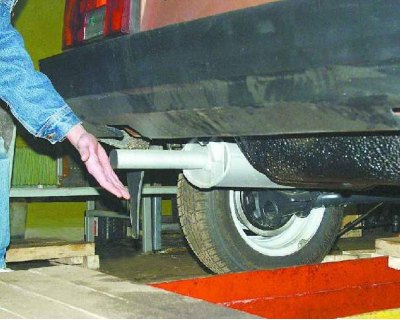
1. Start the engine and leave it to idle. Go to the exhaust pipe and listen to the sound of the exhaust. The sound must be even "soft", one tone. Pops from the exhaust pipe at regular intervals indicate that one cylinder is not working due to the failure of the candle, the absence of a spark on it, a strong air leak into one cylinder or a significant decrease in compression in it. Popping at irregular intervals is due to incorrect carburetor adjustment, ignition, heavy wear or dirty spark plugs.
Exhaust pipe pops at regular intervals?
Yes: see point 3
2. You can try to replace the entire set of candles yourself, regardless of mileage and appearance, but it is better to do this after contacting a car service to diagnose and adjust the carburetor and ignition system.
3. Stop the engine and open the hood.
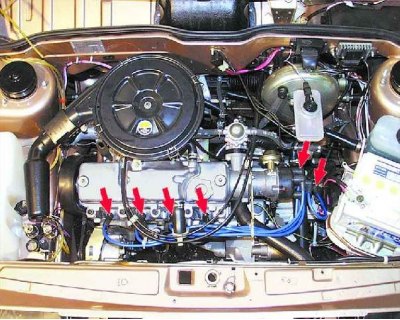
4. Check the condition of the ignition wires. High-voltage wires must not have insulation damage, and their lugs must not be oxidized.
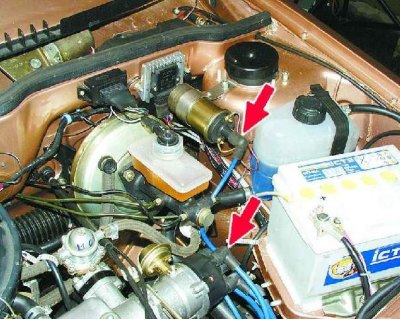
Is there any damage to the wires?
No: see point 6
5. Replace damaged wire.
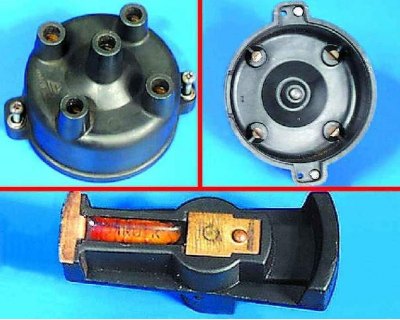
6. Check the condition of the distributor cap and rotor. Loosen the two screws securing the plastic distributor cover and remove it. Inspect the cover inside and out. There should be no cracks, carbon deposits on the cover, and the carbon contact should be damaged or worn out. The rotor must not have cracks or burnouts. Replace defective or questionable parts.
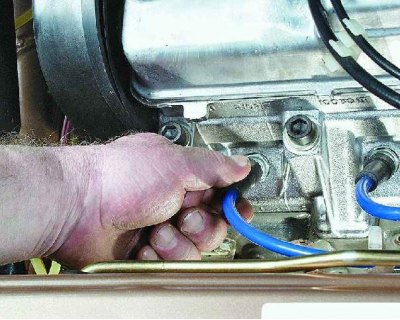
7. Remove the tips of high-voltage wires and turn out the candles with a candle wrench.

Warning! When removing high voltage wire lugs, never pull on the wire itself. Grasp the tip directly with your hand and rotate it from side to side before removing it, then pull.
8. Carefully inspect the candles and compare their appearance with the photographs at the end of the section. The gap between the electrodes of the spark plug should be 0.8–0.9 mm. If the candle is black and damp, it can be discarded.

9. If all the spark plugs look good, reinstall them and reconnect the high voltage wires.
The order of operation of cylinders 1–3–4–2, the numbering of cylinders (1st, 2nd, 3rd, 4th) It is made from the plastic casing of the timing belt drive. On the distributor cover, the number 1 indicates the 1st cylinder, then counterclockwise, if you look at the cover from the side of the high-voltage wire sockets, the 3rd, 4th, 2nd.

10. Take a spare candle. Fix it to the engine in any way.
Warning! Do not fix the spark plug on the oil filler neck, oil dipstick, fuel pump, fuel hoses, carburetor.
Reliable contact of the body or threaded part of the candle with "weight" optional, but desirable. Connect the high voltage wire from cylinder 1 to the spare spark plug. Start the engine.
Has the engine malfunction gotten worse?
Yes: see point 13.
11. Replace the spark plug in the cylinder with a known good one. Put on the high voltage wire and start the engine.
Do engine interruptions continue?
Yes: see point 14.
12. Bon Voyage!
13. Consistently repeat the procedure of paragraphs 10–11 with all cylinders.
14. If, as a result of the measures taken, engine interruptions are not eliminated, contact a car service to diagnose the ignition system at the stand or diagnose the engine - measuring compression. Normal compression - more than 1.1 MPa (11 kgf/cm2), the difference is more than 0.1 MPa (1 kgf/cm2) in one cylinder indicates the need for engine repair.

Tip: If the diagnosis reveals a malfunction of the 3rd cylinder, remove the hose connecting the vacuum brake booster to the engine, shut it off securely and start the engine.
If the interruptions in the operation of the engine have stopped, contact a car service for diagnostics and replacement of the vacuum brake booster.
If engine misfires continue, try a WD40 type fluid to spill the hose on the outside. If the engine stops intermittently even for a short period of time, try replacing the hose.
Diagnostics of the engine condition by the appearance of spark plugs
 | Normal Symptoms.Brown or greyish-yellowish color and slight wear of the electrodes. Accurate thermal value for engine and operating conditions. Advice.When replacing spark plugs with new ones, use spark plugs with the same specifications. | |
 | soot deposits Symptoms.Dry soot deposits indicate a rich air/fuel mixture or delayed ignition. Causes misfiring, difficult starting and erratic engine operation. Advice.Check if the air filter is clogged, the fuel level in the carburetor float chamber, the ignition timing, use more "hot" candle (elongated insulator with central electrode). | |
 | Oil deposits Symptoms.Oily electrodes and spark plug insulator. The reason is oil getting into the combustion chamber. Oil enters the combustion chamber through valve guides or piston rings. Causes difficult starting, misfiring of the cylinder and twitching of the running engine. Advice.Make the necessary repairs to the cylinder head and piston group of the engine. Replace spark plugs. | |
 | Overheat Symptoms.Glossy white center electrode insulator, burnt electrodes and no deposits. Leads to a reduction in the resource of candles. Advice.The reasons may be: mismatch of the type of spark plug recommended for your car engine, early ignition, lean mixture, air leakage into the intake pipe. Check the coolant level and check if the radiator is clogged. | |
 | Early ignition Symptoms.Melted electrodes. The insulator is white, but may be dirty due to spark gaps and deposits from the combustion chamber falling on it. May cause engine damage. Advice.Check the correct spark plug type, ignition timing, air/fuel mixture, cooling and lubrication systems. | |
 | Glaze Symptoms.The insulator is yellowish, glazed. Indicates that the temperature in the combustion chamber rises unexpectedly during hard acceleration of the vehicle. Normal deposits become conductive. Causes misfires at high speeds. Advice.Install new spark plugs. Try installing more "cold" spark plugs if you don't want to change your driving style. | |
 | Bridge between electrodes Symptoms.Deposits from the combustion chamber fall between the electrodes. "heavy" deposits collect in the gap between the electrodes and form a bridge. The candle ceases to work and the cylinder is switched off from work. Advice.Identify the faulty spark plug and remove deposits between the electrodes. | |
 | Ash deposits Symptoms.Light brown deposits crusting the center and side electrodes. They are isolated from additives to oil or gasoline. Too many can insulate the spark plug electrodes, causing misfiring and misfiring during acceleration. Advice.If excessive deposits form in a short time or at low mileage, replace the valve guide valve stem seals to prevent oil from entering the combustion chamber. If the reason is the quality of gasoline, change the place of refueling. | |
 | Wear Symptoms.Rounded electrodes with a small amount of deposits on the working ends. Normal color. Causes difficult starting in cold or wet weather and poor fuel economy. Advice.Replace with new spark plugs with the same specifications. | |
 | Detonation Symptoms.The insulator may be cracked or chipped. This may damage the piston. Advice.Make sure the octane rating of the gasoline is correct. | |
 | Spotted deposits Symptoms.The soot deposited in the combustion chamber, after proper adjustment, begins to burn out and, at high engine speeds, breaks away from the piston and sticks to the spark plug insulator, causing individual gaps in its operation. Advice.Replace spark plugs with new ones or clean old ones. | |
 | Mechanical damage Symptoms.Damage can be caused by foreign objects entering the combustion chamber, and if too long a spark plug is used, its electrodes can catch on the piston. This leads to the destruction of the candle, the shutdown of the cylinder and may damage the piston. Advice.Remove the foreign object from the cylinder and (or) replace the spark plug. | |
